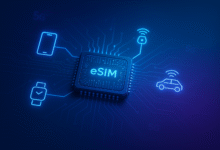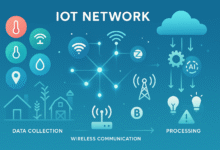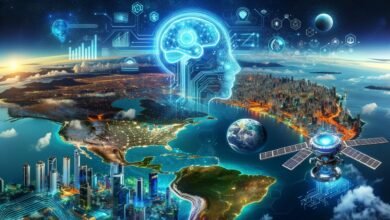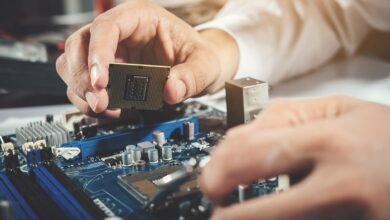Top IoT Platforms for Enterprises in 2025: A Comparison Guide
This comprehensive comparison guide will explore the top IoT platforms for enterprises in 2025, providing an in-depth analysis of their capabilities and helping organizations make informed decisions.
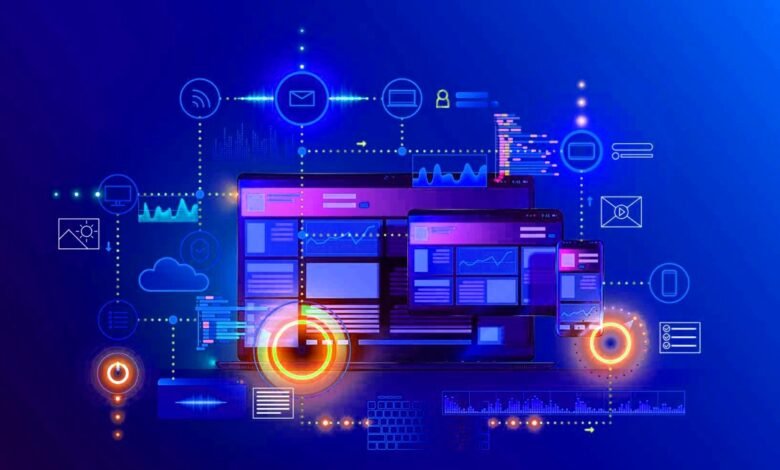
As Internet of Things (IoT) adoption continues to surge, enterprises are seeking reliable, scalable, and secure platforms to manage their connected ecosystems. From manufacturing and logistics to healthcare and retail, the IoT platform market is expanding rapidly, bringing a host of options for businesses to evaluate. With 2025 now underway, it’s crucial for decision-makers to understand which platforms lead the industry and how they compare in terms of features, integrations, scalability, and security.
This comprehensive comparison guide will explore the top IoT platforms for enterprises in 2025, providing an in-depth analysis of their capabilities and helping organizations make informed decisions.
What is an IoT platform?
An IoT platform is a suite of integrated software services and tools that facilitate the connection, management, and monitoring of devices in an IoT network. These platforms serve as the backbone for any IoT solution by handling data ingestion, device management, analytics, security, and application enablement. Choosing the right platform can significantly impact the success and ROI of an enterprise’s IoT strategy.
Why Enterprises Need IoT Platforms in 2025
As the number of connected devices exceeds 30 billion in 2025, the complexity of managing IoT systems continues to rise. Enterprises need platforms that offer:
-
Real-time analytics for faster decision-making
-
Scalable infrastructure to support massive data influx
-
Edge computing capabilities to reduce latency
-
Enhanced security to mitigate cyber threats
-
Integration tools for seamless connection with legacy systems and cloud services
The competitive advantage lies in using a platform that not only connects devices but also extracts actionable insights and automates processes efficiently.
Key Features to Consider in an Enterprise IoT Platform
Before diving into specific platforms, it’s important to highlight the core features that enterprises should evaluate:
-
Device Management: Onboarding, provisioning, and monitoring of IoT devices
-
Data Processing and Storage: Ability to handle high-volume streaming data
-
Security and Compliance: End-to-end encryption, identity management, GDPR and HIPAA compliance
-
Edge and Cloud Integration: Support for edge computing and hybrid cloud environments
-
AI and ML Capabilities: Advanced analytics, anomaly detection, predictive maintenance
-
API Accessibility: Open APIs for customizing and extending functionalities
-
User Interface and Usability: Intuitive dashboards and visualization tools
-
Support and Ecosystem: Strong developer community, documentation, and customer support
1. Microsoft Azure IoT Hub
Microsoft Azure IoT Hub remains one of the most powerful and widely adopted platforms in 2025. It offers deep integration with Microsoft’s ecosystem, making it ideal for enterprises already using tools like Azure Cloud, Power BI, and Dynamics 365.
Key Strengths:
-
Scalability: Supports millions of simultaneous device connections
-
Edge Computing: Azure IoT Edge allows processing closer to the source
-
Security: Features like X.509 certificate authentication, per-device access control, and integration with Azure Security Center
-
Ecosystem Integration: Seamless connection with Azure Machine Learning, Cognitive Services, and Digital Twins
Ideal For:
Large-scale enterprises in industries like manufacturing, energy, and automotive are seeking robust cloud infrastructure with AI and ML capabilities.
2. AWS IoT Core
Amazon Web Services (AWS) IoT Core offers a fully managed service that enables secure communication between IoT devices and the AWS cloud. Known for its flexibility and performance, AWS IoT Core continues to lead in infrastructure reliability.
Key Strengths:
-
Serverless Architecture: Reduces management overhead
-
Machine Learning Integration: Native support for SageMaker and IoT Analytics
-
Security: Built-in support for mutual authentication and encryption
-
Global Infrastructure: Leverages AWS’s global data centers for optimal performance
Ideal For:
Tech-savvy enterprises and developers needing modular and highly customizable IoT solutions.
3. Google Cloud IoT
Google Cloud IoT offers a clean, analytics-driven platform that is particularly suited for enterprises looking to harness AI and big data analytics. Integration with Google BigQuery and TensorFlow gives it a strong edge in data intelligence.
Key Strengths:
-
Data Analytics Focus: Real-time insights and predictive analytics
-
Security: Multi-layered approach with Cloud IAM and endpoint verification
-
AI-first Approach: Uses Google’s AI/ML tools for powerful data modeling
-
Open Source Compatibility: Supports open standards like MQTT and HTTP
Ideal For:
Enterprises in logistics, retail, and smart cities are seeking to combine IoT with AI-driven insights.
4. IBM Watson IoT Platform
Backed by IBM’s legacy in enterprise solutions, the Watson IoT Platform offers a cognitive-driven platform that goes beyond connectivity. It integrates AI, blockchain, and edge computing, making it suitable for highly regulated and data-intensive industries.
Key Strengths:
-
AI-Powered Insights: Advanced natural language processing and machine learning
-
Blockchain Integration: For secure device-to-device transactions
-
Predictive Maintenance: Industry-focused modules for proactive maintenance
-
Security: Trusted hardware support and multi-tier access controls
Ideal For:
Enterprises in sectors like healthcare, automotive, and supply chain management that require advanced analytics and secure data sharing.
5. Cisco IoT Control Center
A network-first platform, Cisco IoT Control Center offers strong device lifecycle management and connectivity options for mobile and cellular IoT deployments. With 5G now mainstream, Cisco is leveraging its telecom partnerships for next-gen connectivity.
Key Strengths:
-
Mobile Connectivity: Optimized for cellular networks, including 5G and LTE
-
Automation: Rule-based automation for device provisioning and billing
-
Security: Network-level threat detection and segmentation
-
Global Reach: Integration with more than 50 global telecom operators
Ideal For:
Telecom providers and enterprises managing large mobile IoT fleets like smart meters, vehicles, or wearable devices.
6. Siemens MindSphere
MindSphere is Siemens’ industrial IoT platform focused on Industry 4.0. It offers a complete suite of tools for managing industrial assets and enabling predictive analytics through integration with PLM and MES systems.
Key Strengths:
-
Industry-Centric Design: Tailored for manufacturing, energy, and infrastructure
-
Data Lakes: Aggregates and standardizes data from multiple sources
-
App Ecosystem: Offers a growing marketplace of industrial apps
-
Digital Twin Support: Enables real-time simulation of physical systems
Ideal For:
Industrial enterprises requiring full control of operational data and seamless integration with factory-floor devices.
7. PTC ThingWorx
Designed for fast deployment, PTC ThingWorx stands out for its developer-friendly environment and focus on augmented reality (AR) and digital twin technologies. It empowers enterprises to build IoT applications rapidly without deep coding knowledge.
Key Strengths:
-
Low-Code Development: Speeds up time-to-value
-
AR Integration: Enhances asset visualization and user training
-
Scalability: Proven use in large industrial deployments
-
Third-Party Integration: Compatible with major ERP, PLM, and CAD tools
Ideal For:
Companies focused on innovation, user experience, and building custom IoT applications with minimal coding effort.
8. Oracle IoT Cloud
Oracle IoT Cloud combines device management with strong analytics and integration capabilities. Known for its deep enterprise application stack, Oracle’s platform is ideal for companies already using its ERP, CRM, or supply chain products.
Key Strengths:
-
Integration with Oracle Cloud Suite: Real-time data flow into enterprise apps
-
AI and Automation: Features like automatic anomaly detection and forecasting
-
End-to-End Security: From data source to cloud application
-
Developer Tools: REST APIs and SDKs for flexible app development
Ideal For:
Large enterprises leveraging Oracle’s ecosystem who want to embed IoT insights into business operations.
Comparison Table: IoT Platforms for Enterprises in 2025
| Platform | Best For | AI/ML Integration | Edge Support | Security | Ecosystem Integration |
|---|---|---|---|---|---|
| Microsoft Azure IoT | Industrial & enterprise-scale apps | Yes | Yes | High | Excellent |
| AWS IoT Core | Custom & scalable solutions | Yes | Yes | High | Excellent |
| Google Cloud IoT | AI/Analytics-driven insights | Excellent | Moderate | High | Strong |
| IBM Watson IoT | Regulated industries | Excellent | Yes | Very High | Strong |
| Cisco IoT Center | Mobile & telecom networks | Moderate | High | Very High | Moderate |
| Siemens MindSphere | Industrial IoT & smart factories | Good | Yes | High | Industry-focused |
| PTC ThingWorx | Custom apps & AR experiences | Good | Yes | High | Strong |
| Oracle IoT Cloud | ERP-connected enterprises | Good | Moderate | High | Excellent |
There is no one-size-fits-all when it comes to choosing the best IoT platform for enterprises in 2025. The decision depends on your specific industry needs, existing tech stack, and long-term digital transformation goals.
-
If you’re focused on industrial automation, Microsoft Azure IoT and Siemens MindSphere provide robust, scalable solutions.
-
For AI-heavy applications and predictive analytics, Google Cloud IoT and IBM Watson IoT shine.
-
If you value network connectivity and device management at scale, Cisco IoT and AWS IoT Core are top contenders.
-
And for those deeply invested in enterprise software ecosystems, Oracle IoT Cloud and PTC ThingWorx offer seamless integration and rapid deployment.
As enterprise demands grow more complex in 2025, investing in a future-ready, secure, and scalable IoT platform is not just a choice—it’s a competitive necessity.
